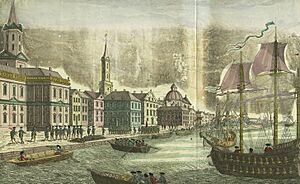Richard Howe, 1st Earl Howe facts for kids
Quick facts for kids
The Earl Howe
|
|
|---|---|
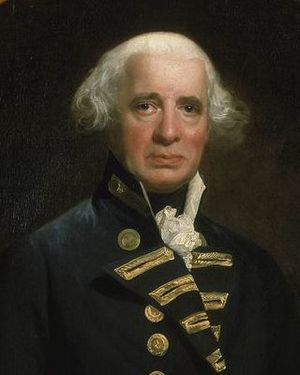
Richard Howe, painted by John Singleton Copley, 1794
|
|
| Born | 8 March 1726 London, England |
| Died | 5 August 1799 (aged 73) London, England |
| Buried | |
| Allegiance | |
| Service/ |
|
| Years of service | 1740–1799 |
| Rank | Admiral of the Fleet |
| Commands held |
|
| Battles/wars | |
| Awards |
|
| Spouse(s) |
Mary Hartop
(m. 1758) |
Richard Howe, 1st Earl Howe, was a famous British naval officer. He was born on March 8, 1726, and died on August 5, 1799. He was known for his important role in several wars.
Howe was especially good at planning attacks from the sea onto land. He used these skills during the Seven Years' War against France. He also helped the British win a big naval battle called the Battle of Quiberon Bay in 1759.
Later, during the American Revolutionary War, Howe was a naval commander. He also tried to make peace with the American rebels. He successfully helped relieve the Great Siege of Gibraltar near the end of that war.
One of his most famous victories was leading the British fleet at the Glorious First of June battle in 1794. This happened during the French Revolutionary Wars.
Contents
Richard Howe was born in London. His father, Emanuel Howe, was the governor of Barbados. Richard went to Eton College for his education.
He joined the navy in July 1739 when he was 13 years old. His first ship was HMS Pearl. He then sailed with Admiral George Anson on HMS Severn around Cape Horn.
Howe served in the West Indies and was part of an attack on La Guaira in 1743. He became a lieutenant in 1744. In 1745, he was promoted to commander and led the sloop HMS Baltimore. He was badly wounded in the head during a fight with French privateers.
In April 1746, he became a post-captain. He commanded several ships, including HMS Triton and HMS Rippon. By 1752, he was commanding HMS Dolphin in the Mediterranean Fleet.
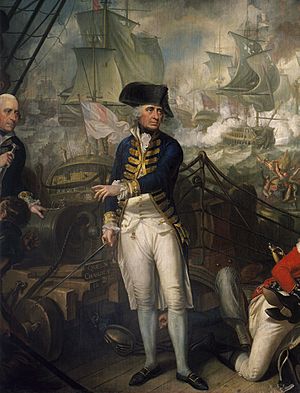
Seven Years' War
In 1755, Howe took command of HMS Dunkirk. He was sent to North America. His capture of the French ship Alcide was the first shot of the Seven Years' War.
Howe was elected to Parliament for Dartmouth in 1757. He then commanded HMS Magnanime in the English Channel. He became known for his skill in naval attacks on the French coast. These included raids on Rochefort, St Malo, and Cherbourg. People praised his calm and steady leadership.
After his older brother died in 1758, Howe became Viscount Howe. In November 1759, he played a key role in the Battle of Quiberon Bay. The British won a major victory, stopping a planned French invasion of Britain.
Howe joined the Board of Admiralty in 1763. He was promoted to rear admiral in 1770 and became Commander-in-Chief of the Mediterranean Fleet. In 1776, he became a vice admiral and Commander-in-Chief of the North America and West Indies Station.
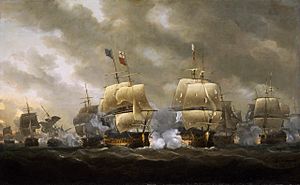
American Revolutionary War
At the start of the American Revolutionary War, Howe was sympathetic to the American colonists. He and his brother, General Sir William Howe, were sent to try and make peace.
Howe was ordered to set up a naval blockade of the American coast. However, he felt he did not have enough ships to do this effectively. This allowed French supplies to reach America. Some historians believe Howe's limited blockade was due to his hope for peace with the Americans. By 1778, the blockade improved, and many merchant ships were captured.
New York and Philadelphia Campaigns
The British strategy was to capture major cities and blockade the coast. Howe's navy worked with the army to capture Long Island and New York City in 1776. He also helped his brother's army capture Philadelphia in 1777. Howe then focused on taking Fort Mifflin and Fort Mercer to control the Delaware River.
In summer 1778, a French fleet arrived in America. Howe's fleet faced them off Point Judith. A big storm scattered both fleets, causing damage. Howe later chased the French fleet to Boston. He left his station in September 1778.
Howe returned to England. He felt he hadn't received enough support during his command in America. He spent the next three years criticizing the government's handling of the war at sea.
Command of the Channel Fleet
In March 1782, Howe accepted a new command. He became the commander of the Channel Fleet in April 1782. He was promoted to full admiral and became Viscount Howe in the Peerage of Great Britain.
Howe's job was difficult. He had to protect trade ships, watch the French and Spanish fleets, and keep an eye on the Dutch fleet. He also needed to relieve Gibraltar, which had been under siege for years. He had fewer ships than his enemies.
Howe successfully protected a convoy from the West Indies. He used a clever route around the Isles of Scilly to get between the convoy and the enemy fleet. The enemy fleet was then blown south by a storm.
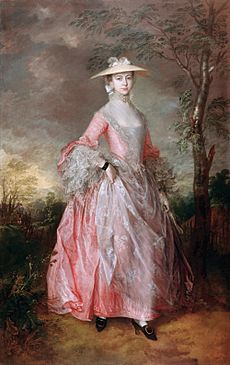
Relief of Gibraltar
In September 1782, Howe successfully relieved Gibraltar. This was a very challenging operation. He faced 46 French and Spanish ships with only 33 of his own. He escorted a large convoy of supplies to Gibraltar.
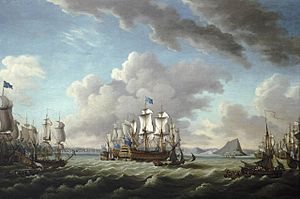
After relieving Gibraltar, he fought an indecisive battle at Battle of Cape Spartel in October 1782. He then brought his fleet safely back to Britain. This ended the naval campaign.
First Lord of the Admiralty
Howe became First Lord of the Admiralty in January 1783. This meant he was in charge of the Royal Navy. It was a tough job because he had to manage the navy with a small budget. He also had to deal with many officers who were out of work after the war.
During his time, new ships were built as part of a naval competition with France and Spain. Howe also introduced new ways of using signals in the navy. He resigned in 1788 and was awarded an Earldom.
In 1790, there was a dispute between Britain and Spain over the Nootka Sound in North America. This threatened to start a war. Howe, as an experienced officer, was given command of the fleet. He led the Channel Fleet on a cruise before the crisis was solved peacefully.
French Revolutionary Wars
When the French Revolutionary Wars began, Howe was again given command of the Channel Fleet in 1793. In June 1794, he led a British fleet of 22 ships against a French fleet of 25 ships. The French ships were protecting a grain convoy.
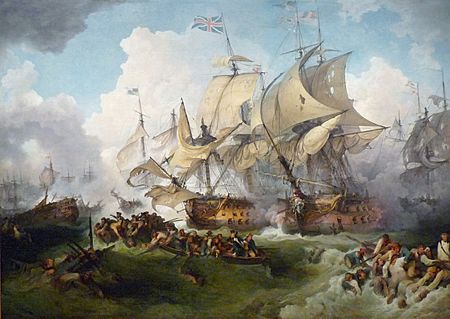
Howe's fleet won a great victory at the Glorious First of June battle. They captured seven French ships. For this important win, he received a large Naval Gold Medal. He was promoted to Admiral of the Fleet in 1796.
Later Life
In May 1797, Howe helped calm down the Spithead mutineers. He spent many hours talking to the sailors, and peace was restored. For this, he was made a Knight of the Order of the Garter.
Richard Howe died on August 5, 1799, in London. He was buried in his family vault in St Andrew's Church, Langar. A monument to him is in St Paul's Cathedral.
Many places are named after Admiral Howe, including:
- Cape Howe, Australia
- Torbay Head, Torbay Inlet, and Torbay, Western Australia, Australia
- West Cape Howe, Australia
- Richard Island, Australia
- Lord Howe Island, Australia
- Howe Sound, British Columbia, Canada
- Howe Street, Vancouver, British Columbia, Canada
Family
Richard Howe married Mary Hartop in 1758. They had three daughters. Since they had no sons, his titles of Viscount and Earl Howe ended when he died.
His oldest daughter, Sophia Howe, became Baroness Howe. She married twice and had children. Her oldest surviving son, Richard, was later made Earl Howe in 1821.
Images for kids
-
Richard Howe, painted by John Singleton Copley, 1794
-
Lord Howe on the Deck of the 'Queen Charlotte', 1 June 1794, by Mather Brown
-
The Battle of Quiberon Bay by Nicholas Pocock. Howe took part in the battle as a captain. The overwhelming British victory at Quiberon Bay ended the prospect of a French Invasion of Britain or Ireland.
-
Mary, Countess Howe, by Thomas Gainsborough
-
Relief of Gibraltar by Earl Howe, 11 October 1782, by Richard Paton. Howe, flying his flag aboard the 100-gun HMS Victory in the centre, approaches Gibraltar. To the right are the ships of the van, with Vice-Admiral Samuel Barrington's 100-gun HMS Britannia, and to the left, those of the rear squadron, commanded by Vice-Admiral Mark Milbanke in the 98-gun HMS Ocean. The Franco-Spanish fleet can be seen in the background, anchored in Algeciras Bay.
-
The Glorious First of June by Philip James de Loutherbourg (1795)


